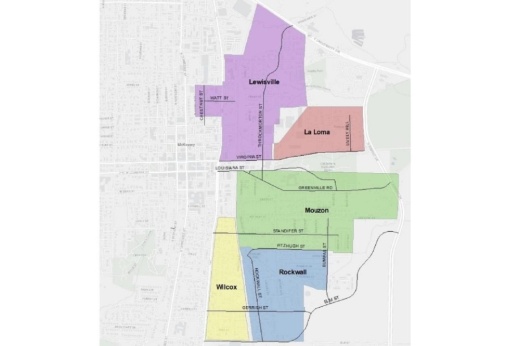The council received an update on the Neighborhood Preservation Study initiative at its Dec. 6 meeting. The initiative began in early 2021 to address concerns of rising housing costs due to surrounding development projects in McKinney’s five historic east-side neighborhoods: La Loma-Lively Hill, Lewisville, Mouzon-Central, Rockwall and Wilcox.
The study, conducted by independent consultants Economic & Planning Systems, evaluated relevant information, such as ownership data, the condition of residential and commercial properties in the area, average home sale price, and more. The study concluded the roughly 3,500 residents of the affected neighborhoods are particularly vulnerable to displacement when compared to the rest of McKinney. About 56% of surveyed residents also indicated they intend to remain in their home for 10 or more years, according to the report.
“The Neighborhood Preservation Study came about in an effort to make sure that the residents that wanted to remain in their homes were able to do so,” said Janay Tieken, director of the Housing and Community Development Department.
The report also noted east side residents are more diverse, have significantly lower median household incomes and are growing as a population at a slower rate than the rest of the city. The affected neighborhoods have also seen a significant increase in the median home sale price since 2010, according to the report.
The report included feedback from east side residents and city residents collected through a community survey. The feedback collected from 173 east side residents indicated they are facing financial challenges and are interested in financial assistance programs for things, such as home repairs, down payments, utility payments and more, according to the report.
The presentation given to council on Dec. 6 by representatives of Economic & Planning Systems outlined various strategies, policies and tools that could be implemented to help mitigate the impact of development on east side residents. Proposed solutions include implementing a community land trust, creating or expanding an existing tax increment reinvestment zone, and bolstering the city’s housing rehabilitation program. These tools target costs incurred by property taxes, house repairs and more, and are intended to provide financial relief.
Council members expressed concerns regarding the use of a community land trust, citing potential issues in implementing the tool for homes being rented out or being passed through generations of family members. Council Member Geré Feltus noted her desire for this strategy to retain home ownership for residents passing their property to the next generation.
“One of the best ways to increase generational wealth is to pass on home ownership, so I would like to see us really reach for that better as we're creating these policies,” Feltus said.
The council also noted concern about how to protect residents who are renting their east-side homes. About 60% of residents in the affected neighborhoods rent their homes, according to the report. Various council members expressed interest in learning more about how the tools would protect renters and home occupants, as opposed to the landlord.
“My advocation has always been for protecting residents that live there now and allowing them to be able to remain there without the cost of rising values to push them out. That's extremely important,” McKinney Mayor George Fuller said.
The council did not take action and requested an additional work session to learn more about the proposed strategies, further discuss the topic and provide input on which solutions the city should pursue. The next work session discussing the project will likely be in January, Tieken said.
For more information on the Neighborhood Preservation Study, visit www.mckinneytexas.org/3340/Studies#NPS. To give feedback or ask questions, contact Janay Tieken at 972-547-7578 or [email protected].





